As I wandered through the temples of Tirunelveli, I kept coming across pairs of donor figures, usually flanking a mandapam. One a Saiva and the other a Vaishnava. Here’s one such pair from the Vanamamalai Perumal temple, Nanguneri.

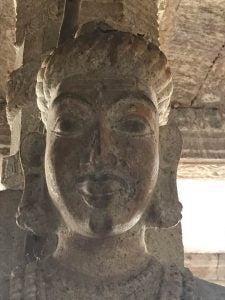

On Tamil, Temples and Translations
As I wandered through the temples of Tirunelveli, I kept coming across pairs of donor figures, usually flanking a mandapam. One a Saiva and the other a Vaishnava. Here’s one such pair from the Vanamamalai Perumal temple, Nanguneri.


This morning was the Mattaiyati Utsavam here at Nanguneri. It was great fun, and I enjoyed everyone’s laughter. The premise is that the goddess is mad at Vishnu for going out without informing her, and she suspects the worst. When he returns, she’s barred the temple doors to him. He tries to sweet-talk his way in, to no avail, until the Alvar (here Tirumankai) has to intercede to patch them up.
There’s much that one can say about this festival, and a whole host of questions about it as well. But what I was excited by was the mirror. Totally unexpected. There it was, tucked into the palanquin for Devanayakan to see himself in, all the while that the goddess will not see him.
There is one photograph that I took that is I think a once in a lifetime shot. It is the moment, when Devanayakan has shown up to find that the first door is barred to him. In this photograph, you see a tiny bit of the back of the god, the door he faces, behind which is the angry goddess, who refuses to see him, and in the mirror you see the god, and most awesome of all, a donor figure, with his palms pressed together.
All photographs taken in public spaces or during public processions with the permission of the temple authorities.
This morning, I visited a gorgeous jewel of a temple located right on the banks of the Tamaraparani. The location is so scenic, idyllic, really. One can walk to the river bank from the temple, although this path was closed as the temple priest hadn’t shown up.
The temple has one of the most delicately carved, richly detailed vimanas I’ve seen. While the rest of the temple is quite plain–there are a few striking sculptures on pillars and so forth–the real workmanship is in the vimana, where the long ago, anonymous artists have worked hard, unrelenting granite as though it’s soft as soap, pliable as wax. I was thinking of Crispin Branfoot’s work on the expanding temple, and how well this gem exemplified it. There are inscriptions galore to delight the epigraphist’s heart, many of them unrecorded/unreported. Leslie Orr has probably been here many times over.
The temple had fallen into terrible disrepair some ten years back. It then came under the control of the Central ASI, who took the temple apart and rebuilt it. It’s now a well maintained temple, with a priest who keeps the temple open in the morning from 8-11 AM. And the morning light made an already striking temple even more gorgeous. The stone just glowed in some places.
I will certainly be returning, hopefully many times over, to really take in the beauty of that stunning vimana.
Also, on the vimana, an extraordinary Narasimha, the likes of which I’ve never seen.
Bhakatavatsala Perumal Temple, Cheranmahadevi.
Well, the Vetu Pari at Nanguneri is done. Unlike other places in the region, this temple hosts the festival in the morning. After a few days of rain, all the dust has cleared from the air, and the day was utterly glorious. The sky a blinding blue, and the sun brightly golden. Everything sparkled–the light glinting off the massive horse, his spear, the Sathari, and the god. Yet, Tirumankai was obscured, hidden inside his little palanquin. I didn’t think that was in error.
The festival is beautifully choreographed. The men hoist the immense horse on to their shoulders with a great cry and heave, and they move with delicacy, precision and sturdiness navigating their way through the temple corridor and out into the street. They move slowly, and it gives the feeling of a horse at a gentle canter. The drums are beating in a rhythm that mimics the clap of a horse’s hooves. Then suddenly, Tirumankai appears. He urgently circles Devanayakan three times–the god behind a screen is visible to us, but invisible to Tirumankai. He’s checking out all the jewels ready for thieving. The drums have changed their rhythms, and now the beats evoke urgency and piracy. The god evades him, Tirumankai gives chase, eventually cornering him (quite literally). He robs the god, and takes off at a great run (well, more like a leisurely trot), now the god in pursuit. The roles have been deliberately reversed, as have their positions relative to each other in the procession.
By the time they reach the mandapam right outside the main gopuram, Tirumankai has come to his senses, and realized who he’s robbed. Devanayakan too has shed his screen, and is visible. Tirumankai, though still remains in the dark and in shadow. Once he surrenders the wealth he’s stolen, returned what was never his to begin with, he moves forward, a little closer to the god towering above him. It was quite remarkable, and I am sure unplanned, that when they moved Tirumankai forward, he came under a beam of light and was suddenly visible even in the dark cave of his palanquin.
The Ira Pattu of the Adhyayanotsavam is a sober and somber affair. It’s a serious business reciting the Tiruvaymoli. The god descends every evening, and the feeling for the devotees gathered is awe–awe at god’s grandeur, and awe that the god of gods would choose to descend, to become familiar and knowable to simple folk.
The Vetu Pari Utsavam and the Mattayati that follows it tomorrow evoke a different kind of feeling, anubhava. There is delight, sheer, exuberant, joyous delight. Everyone is smiling, joking, laughing. They love the trick. They’re so happy to be in on the joke. They leave knowing, tomorrow, Devanayakan is going to be in trouble for his wanderings, and all the doors to the temple will be shut to him as he faces the wrath of his wife. I can hardly wait.
Photographs taken in public during the public processions with the permission of the temple authorities.
Today I visited my ancestral village for the very first time. Although I was born in India, grew up here, and my life’s work brings me back to this very place again and again, I’ve never managed to make it to the village. Not once. I’ve even driven past the sign board announcing it a few times. I’ve observed that it is my ancestral village, and that I should come, but I never have. Not until today.

This is the village, deep in beautiful ten-Pandya Nadu, where my maternal grandfather was born and raised. This was where he studied, gaining life-skills that pulled him and his family out of difficult circumstances to forge a better life for all of them. This is where my paternal grandmother studied, where my paternal great-great-grandfather helped run a school. Where my uncles and aunts studied.
This is where the house in which my grandfather was born and lived still stands.
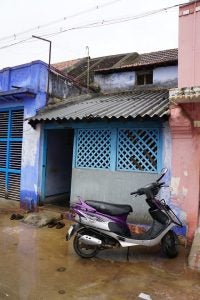
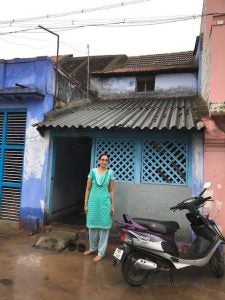
This village is quaint, charming, quiet, lovely. It really is a village–not a town masquerading as a village. The hills rise blue, grey and misty in the deep background. In the foreground, the fields are iridescent green, and birds of all sorts flit and float by, bursts of color against the impossible green. The canal runs cool, swift and clean, beckoning the young boys who hurl themselves with great screeches of joy into its waters. The women and girls bathe on the shores more decorously, but with no less enthusiasm.

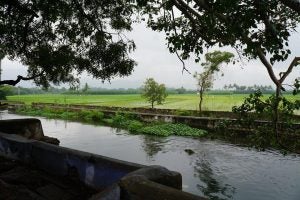
In a land of temples, this village seems thick with them. On either end of the street of my grandfather’s house (Mela-Theru) is a Shivan temple and a Perumal temple. Around the corner is a goddess temple, with the beguiling and deceptive name, Anandavalli–creeper of joy. She did look quite thrilled to be spearing the demon. These are old temples, that hold their marks of oldness even beneath the explosion of overenthusiastic tile and renovation.
On a parallel street, called Kila-Theru, are two more temples–utterly gorgeous–again a Shiva temple and Vishnu temple. The Perumal has the impossibly evocative name Kariya-manikka Perumal. The temple walls are covered in inscriptions, and the temple seems virtually untouched. Same with the 13th century Shiva temple–Vilvanathan–covered in inscriptions, and almost untouched since the time of its first renovation in the 13th century, according to an inscription dated 1203 CE (save for the likely addition of the goddess shrine). I am thinking of Leslie Orr…
My trusty driver, Kesavan, observed that for all my temple wanderings around Tirunelveli, did I think that such treasures lurked so close by? No, I did not. But now that I know, I must return, again and again.
When I was in this village, in the rain, in the embrace of the hills and the fields, I understood in a completely new and different way, why I love this land so much. Why this Pandya Nadu calls to me on some primeval level.
There are so many ways to come home, and having lived between lands for so long, every journey is always a homecoming, in whichever direction I go. Now, I have found another way to come home, another place to call home, and yet another way to to find my way in this vast, vast world.
Day 2 of Ira Pattu. I adored the recitation of the last decad of the 2nd Hundred–Kilar Oli Ilamai–so haunting and slow as befits this really important decad, on Tirumaliruncolai, the first on any single site in the Tiruvaymoli.
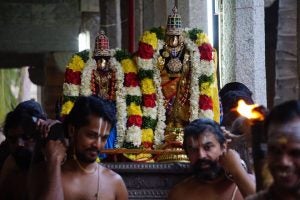
The crowds had thinned considerably today when the Vaikuntha Vasal opened. But still, there were quite a few people rushing through. I didn’t choose my position very well today, which is itself instructive about sight-lines, space, who goes where, and time, what can you see, when do you see.
Today, I was particularly delighted to capture the photograph of Devanayakan and Varamangai in the mirror as they processed through the corridor. Through many years of trying to get similar photographs at various temples, I have always failed. But today, I somehow managed it. What is it about this mirror-seeing that so excites people? I’ve seen this sevai so many times–but it never struck me quite in this way until just a couple of days ago. There’s something about the context of this Sevai (i.e. Vaikuntha Ekadasi and the 9 days after) that makes the whole idea of reflection and looking fascinating to me. Also, there are mirrors in other contexts as well–during processions when a mirror is placed in front of the deity; during the sodasa-upacaras, when a mirror is shown to the deity–and so on. But yes, there is something magical about it–and not just for a child. I think it has to do with the magic and allure of mirrors themselves.
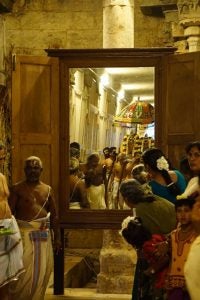
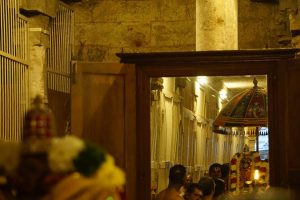
Even as Vishnu processes towards them, all eyes are on the mirror to catch a glimpse of him in it. This is meaningful, I know, because of all the ways that seeing (just as much as hearing) is crucial to the Adhyayanotsavam. Not just us seeing god as he makes his descent, but god seeing himself, to know himself. In other temples, when Vishnu returns in procession in the evening during Pakal Pattu, there is a mirror placed before him, so he can see himself–to see is to know. In Nanguneri, there is no mirror in the palanquin. Instead, the goddess, Varamangai, sits hidden looking at Devanayagan. To look is to know.
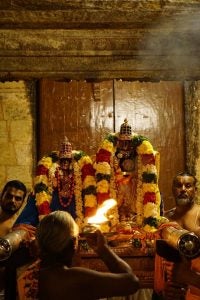
All photographs taken in public spaces during public processions with the permission of the temple authorities.
I took 1500+ photographs this evening of the Vaikuntha Ekadasi celebrations at the temple at Nanguneri. This does not include the 500+ photographs I took this AM! I am MAD.
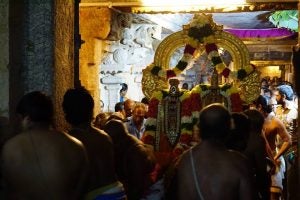
I was told that there 5000 people squeezed into the temple–I simply don’t know how this was possible, but I felt and smelt every one of those 5000 people.
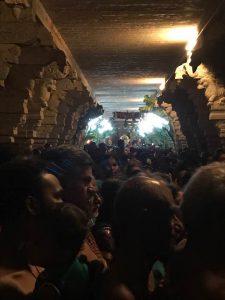
The atmosphere was electric, seething, anxious, filled with love. The air was humid and heavy, and sweat was pouring down my body in great rivers–my pores had become eyes. I thought then, that crying isn’t the only way to dissolve.
There are so many differences in the way that Nanguneri unfolds the opening of the Svarga Vasal. But one thing that struck me is the carefully calibrated waiting. At this temple, things move with an extraordinary, even brutal, efficiency. So, I expected that when the door opened, Vishnu and his dear consort would simply cross over. But no. They waited. And we waited, while the door was scented, blessed, adorned. Only then, after what seemed like an interminable wait, did the god who was a speck in the distance was suddenly so near you could breathe him in–all those flowers. Above the raucous sounds of the percussive tavil and the conch and the nagasvaram, the chant of Govinda, Govinda, Govinda filled the air, bounced off the stone pillars, and just hung in the air, an endless echo. Antati.
Ramanuja and Tirumankai (Nammalvar) were waiting on the other side to greet him–their faces looked so happy, delighted. I imagine that the devotees gathered wore similar expressions of joyful, joyous expectations.
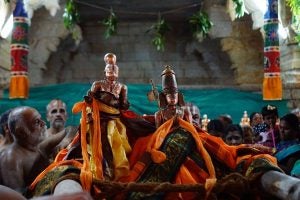
One cannot divorce these affective and experiential things, the careful choreography that maximizes impact, and ignites feeling, liquid and dynamic from the festival itself. This is what gives texture and depth when it culminates in the resonant recitation of the first hundred of the Tiruvaymoli. Word, sound, image, feeling–an endless loop–an antati of bodies of devotion.
I particularly like this image, which frames the processing gods with two expressions of donative piety–there, in the foreground, is the portrait of some anonymous donor, palms pressed together, his face that of a joyous supplicant. In the background, a wall of inscriptions, a cascade of donations and directives, breathing life into the temple, into its people, into its gods.

A few photographs from today. Too many to go through. All taken during the public processions in the public spaces of the temple with the permission of the temple authorities.
PS. At an event like this, it is impossible to take a photograph without a cellphone in the frame.
Adhyayanotsavam Day 2: Nanguneri.
I am still getting my bearings around this temple. I am still learning its rhythms. I spent a quiet hour virtually alone in the temple–there was one sleeping man for the first half hour, and then a few priests and others started wandering in. It’s cool here–even at 2 in the afternoon, and cooler still in the evening with a gentle breeze blowing in across the massive lake. Even still, it was a comfort to shelter within the cool dark stone of the temple’s walls, and stare in perplexed fashion at the silent and inscrutable images that grace its walls and pillars.
Thus far, I’ve found the god here at Nanguneri inscrutable too. He’s called Devanayakan–king/hero among the gods–and he truly seems to be as remote as his name suggests. Even in his daily descent, he seems far away, even with the lovely goddess by his side. Even when he’s displaying himself as the conqueror of snakes and birds, it seems to be a charade–all a play that supposedly masks his transcendence. But in Nanguneri, the mask is translucent. He seems hidden too–even in the eye-watering alankaras, it is difficult to know him.
Or so I thought.
At the end of the evening, as the final camphor flame was waved–the god of gods had returned to himself–a woman standing behind me gasped at the sight, all shadow and light, and she whispered in Tamil–is this *our* Devanayakan? I don’t know what she saw in that moment, but it must have been something so new and fresh and unexpected. In that simple phrase was packed a world of intimacy and a relationship of a lifetime, when someone you’ve known for a long long time suddenly surprises in you in the best way possible.
I, on the other hand, am new to this relationship, and Devanayakan is so far receiving me in the parlor. This too, I suspect is *our* Devanayakan.
Adhyayanotsavam Day 1: Nanguneri.
I met such lovely people today. The two young girls who sang so sweetly for Devanayakan. The old grandma, her body bent with age, but with an ageless face, bright with love. A woman who has been to all 106 Divya Desas. The priests and sevarthis, who guided me with patience and kindness.
Although the Nanguneri temple is large, it’s constructed in a way that everything feels really intimate. The spaces are tight, so you are forced to stand cheek to jowl with your companions. But no one pushes or shoves, instead they ask you to bend lower so they can see above your head, or they make way so someone behind them can catch a glimpse.
In the morning during the Tiruppalandu Todakkam, right before the recitation began, the priests wave lamps and incense before the god–both the primary image and the utsavar. This temple, like so many others in region, is mostly lit from oil lamps. So from the far off distance where we ladies have to stand, Vishnu seems so far away–a dark, shadowy figure, with only the jewel-encrusted naamam glinting at us; his silver eyes twinkling in the light. When they waved the incense this morning, even that was obscured, but as the smoke cleared, it seemed he came into even clearer focus, as though emerging through that smoke. Periyalvar was placed before him–and so it really seemed like he was having the legendary vision that we too were all privileged to witness. And then quiet. The Jiyar’s voice rose, like the smoke, and the opening words of the Tiruppallandu filled the air. What a beginning! It was spectacular.
In the evening, the festival began in earnest, and by the time we were about 30 verses into the Periyalvar Tirumoli, the place had filled. Women sat clustered together following the recitation in their books. The men recited without pause and with a breathless quality. In that closed, small space, the sound felt more intense and concentrated, less dispersed. So too, how we see and experience Devanayakan. The processional corridor is so tight that the palanquin barely fits. You are forced to follow, and you lose sight of the image hidden inside. It’s like an alvar poem come to life–the teasing of presence and absence. To me, this is what the Adhyayanotsavam is about–poetry making a world, a world into which we are drawn each day more deeply and more inextricably.
Tomorrow is Day 2, and the Tirukkolams commence.